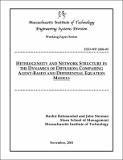| dc.description.abstract | When is it better to use agent based (AB) models, and when should differential equation (DE) models be used? Where DE models assume homogeneity and perfect mixing within compartments, AB models can capture heterogeneity in agent attributes and in the network of interactions among them. Using contagious disease as an example, we contrast the dynamics of AB models with those of the corresponding mean-field DE model, specifically, comparing the standard SEIR model-a nonlinear DE-to an explicit AB model of the same system. We examine both agent heterogeneity and the impact of different network structures, including fully connected, random, Watts-Strogatz small world, scale-free, and lattice networks. Surprisingly, in many conditions the AB and DE dynamics are quite similar. Differences between the DE and AB models are not statistically significant on key metrics relevant to public health, including diffusion speed, peak load on health services infrastructure and total disease burden. We explore the conditions under which the AB and DE dynamics differ, and consider implications for managing infectious disease. The results extend beyond epidemiology: from innovation adoption to the spread of rumor and riot to financial panics, many important social phenomena involve analogous processes of diffusion and social contagion. | en_US |
